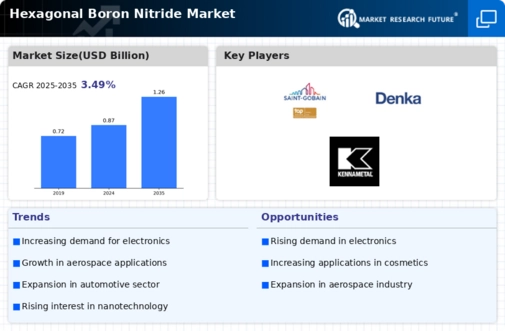Market Share
Hexagonal Boron Nitride Market Share Analysis
In the fiercely competitive Hexagonal Boron Nitride (hBN) Market, companies employ a diverse range of market share positioning strategies to distinguish themselves and gain a competitive edge. These strategies encompass product differentiation, market segmentation, environmental sustainability, strategic partnerships, research and development investment, brand positioning, cost leadership, global expansion, customer relationship management, and quality assurance.
Product Differentiation:
Varied Grades and Purity Levels: Companies focus on offering hexagonal boron nitride in various grades and purity levels to cater to specific industry applications. This allows them to provide customers with hBN products tailored to their precise needs, such as high-purity hBN for electronics or lubricating grades for industrial applications. Functional Additives: Introducing hBN with additional functionalities, such as enhanced thermal conductivity or improved lubricating properties, allows companies to differentiate their products based on superior performance characteristics. Market Segmentation:
Industry-Specific Solutions: Tailoring hexagonal boron nitride solutions to meet the specific demands of industries like electronics, ceramics, lubricants, or cosmetics enables companies to address unique challenges within each sector. Industry-focused formulations cater to niche markets and establish market leadership. Application-Centric Offerings: Recognizing diverse applications, companies may customize hBN for specific uses, such as thermal management in electronics or as a release agent in molding processes, optimizing products for targeted customer needs. Environmental Sustainability:
Eco-Friendly Formulations: The increasing emphasis on sustainability leads companies to develop hexagonal boron nitride with reduced environmental impact. Formulations that are eco-friendly, non-toxic, and recyclable align with environmentally conscious practices, appealing to green manufacturing trends. Energy-Efficient Processes: Implementing energy-efficient manufacturing processes contributes to sustainability goals and positions companies as environmentally responsible suppliers. Strategic Partnerships and Alliances:
Collaboration with End-Users: Forming strategic partnerships with end-users, such as electronics manufacturers or lubricant producers, allows hBN suppliers to understand specific application needs and co-develop tailored solutions. This collaboration enhances the compatibility and effectiveness of hexagonal boron nitride. Supply Chain Collaboration: Building strategic alliances within the supply chain, including raw material suppliers and distributors, optimizes the production and delivery processes, ensuring timely availability of hBN. Investment in Research and Development:
Innovative Formulations: Companies that invest significantly in research and development gain a competitive advantage by introducing innovative hBN formulations. Continuous innovation enables the development of hexagonal boron nitride with enhanced properties, meeting evolving industry requirements. Adapting to Technological Advances: Staying abreast of technological advancements, such as advancements in nanomaterials or 2D materials, allows companies to provide cutting-edge hBN solutions that align with industry trends. Brand Positioning and Marketing:
Effective Branding: Building a strong brand presence and identity is crucial for standing out in the hBN market. Effective marketing strategies, including targeted advertising, participation in industry conferences, and online presence, contribute to increased visibility and brand recognition. Educational Initiatives: Informative campaigns that educate manufacturers and end-users about the benefits and applications of hexagonal boron nitride create awareness and position a company as a knowledgeable industry leader. Cost Leadership Strategies:
Economies of Scale: Achieving economies of scale through efficient production processes allows companies to offer cost-competitive hexagonal boron nitride without compromising quality. This is particularly important for hBN used in high-volume applications. Value-Based Pricing: Emphasizing the value proposition of hBN, such as its unique properties leading to improved product performance or extended equipment lifespan, justifies higher upfront costs and positions products as long-term investments. Global Expansion Strategies:
Entering Emerging Markets: Identifying and entering emerging markets provides opportunities for growth and expansion. Tailoring hBN to meet the unique demands of these markets ensures relevance and competitiveness. International Distribution Networks: Establishing a robust international distribution network allows companies to reach a broader customer base. Global expansion enhances the potential for increased market share. Customer Relationship Management:
Technical Support Services: Offering technical support services, including on-site assistance, training programs, and collaborative problem-solving, strengthens the relationship between companies and manufacturers. Responsive Customer Service: Providing responsive customer service and addressing inquiries and issues promptly builds trust and enhances customer loyalty. Quality Assurance and Certification:
Stringent Quality Standards: Adhering to strict quality control measures and obtaining relevant certifications assures manufacturers and end-users of the reliability and performance of hexagonal boron nitride. Compliance with Industry Standards: Aligning products with industry standards and regulatory requirements builds trust among customers and positions a company as a reliable and responsible supplier.






Leave a Comment